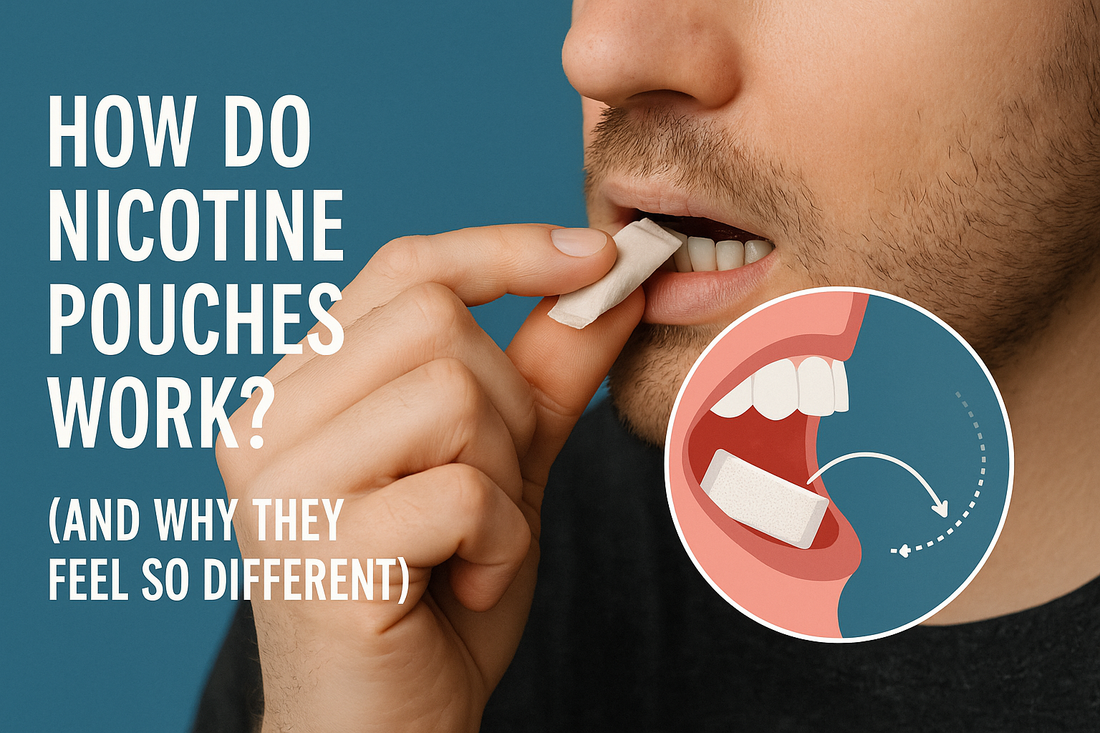
How Do Nicotine Pouches Work? (And Why They Feel So Different)
The world of nicotine delivery has evolved dramatically over the past decade, with nicotine pouches emerging as one of the most innovative and discreet options available. These small, tobacco-free sachets have captured the attention of millions of users worldwide, offering a unique experience that feels distinctly different from traditional smoking or vaping. Understanding the intricate mechanisms behind how nicotine pouches work reveals why they've become such a compelling alternative for nicotine consumption.
The Science Behind Nicotine Absorption
At its core, the nicotine pouch operates on a sophisticated principle of controlled release and absorption. When placed between the gum and lip, the pouch creates an optimal environment for nicotine delivery through the oral mucosa – the thin, highly vascularized tissue that lines the inside of your mouth. This tissue is particularly effective at absorbing substances due to its rich blood supply and permeable nature.
The process begins the moment saliva comes into contact with the pouch. The carefully engineered pouch material allows saliva to penetrate and interact with the contents, initiating a controlled dissolution process. Unlike the rapid combustion of cigarettes or the heated vapor of e-cigarettes, nicotine pouches rely on this gentle, sustained interaction between saliva and the nicotine-containing materials inside the pouch.
The nicotine within the pouch is typically in the form of nicotine salts or synthetic nicotine, which have been specifically chosen for their stability and bioavailability. These forms of nicotine dissolve readily in the slightly alkaline environment created by saliva, allowing for efficient absorption through the oral mucosa. The pH level of the pouch contents is carefully balanced to optimize both comfort and absorption rates, ensuring users experience a smooth, consistent delivery.
The Unique Delivery Mechanism
What makes nicotine pouches feel so different from other nicotine products lies in their unique delivery mechanism. Traditional cigarettes deliver nicotine through the lungs, where the large surface area of the alveoli allows for rapid absorption into the bloodstream. This creates an almost instantaneous nicotine spike, followed by a relatively quick decline. Vaping follows a similar pulmonary absorption pattern, though with different kinetics depending on the device and e-liquid formulation.
Nicotine pouches, however, utilize buccal absorption – the process by which substances pass through the mucous membranes of the mouth directly into the systemic circulation. This method creates a more gradual onset and sustained release profile. The nicotine doesn't need to travel through the digestive system or be processed by the lungs; instead, it enters the bloodstream directly through the rich capillary network beneath the oral mucosa.
This buccal delivery system results in a bioavailability rate that typically ranges from 25% to 50%, depending on factors such as pH levels, nicotine concentration, and individual physiological variations. While this might seem lower than pulmonary delivery, the sustained release nature means that nicotine levels remain more stable over time, providing a different but often more satisfying experience for users.
The Role of pH and Formulation
The effectiveness of nicotine pouches is heavily dependent on the careful balance of pH levels within the pouch formulation. Nicotine exists in two primary forms: protonated (nicotine salt) and unprotonated (free base nicotine). The ratio between these forms is determined by the pH of the environment, and this ratio directly affects how readily the nicotine can be absorbed through biological membranes.
At lower pH levels (more acidic), nicotine predominantly exists in its protonated form, which is more water-soluble but less lipophilic – meaning it has more difficulty crossing cell membranes. At higher pH levels (more alkaline), nicotine shifts toward its free base form, which is more lipophilic and can more easily penetrate biological tissues.
Manufacturers of premium nicotine pouches carefully engineer the pH of their products to optimize this balance. They often include buffering agents such as sodium carbonate or sodium bicarbonate to maintain the ideal pH range throughout the product's use. This precise pH control is one reason why different brands and formulations can feel distinctly different, even when containing similar nicotine concentrations.
Understanding the Sensory Experience
The unique sensory experience of nicotine pouches stems from several factors working in concert. First, the physical sensation differs markedly from smoking or vaping. There's no heat, no vapor, and no combustion involved. Instead, users experience a subtle tingling or mild burning sensation as the nicotine begins to absorb through the oral tissues. This sensation, often described as a "nicotine buzz," is the result of nicotine's interaction with nicotinic acetylcholine receptors in the oral mucosa.
The texture and composition of the pouch itself also contribute to the experience. Modern pouches are typically made from plant-based materials such as eucalyptus or pine fiber, creating a soft, comfortable feel against the gums. The pouch acts as a controlled-release matrix, allowing saliva to penetrate while containing the active ingredients and preventing them from dispersing throughout the mouth.
Flavor plays a crucial role in the overall experience as well. The flavoring agents used in nicotine pouches are carefully selected not just for taste, but for their ability to complement the nicotine delivery mechanism. Some flavors can actually enhance absorption by affecting saliva production or by creating a more favorable pH environment. Mint flavors, for example, can create a cooling sensation that masks any harshness from the nicotine while potentially increasing local blood flow, which may enhance absorption.
The Time-Release Profile
One of the most distinctive aspects of nicotine pouches is their extended release profile. Unlike the immediate hit from a cigarette or the quick satisfaction from a vape, nicotine pouches provide a sustained release over 30 to 60 minutes. This extended timeline is the result of the controlled dissolution and absorption process.
In the first few minutes after placement, the pouch begins to hydrate as saliva penetrates the material. During this initial phase, users may notice the onset of flavor and a subtle sensation as the nicotine begins to release. The peak absorption typically occurs between 15 to 30 minutes, during which users experience the most pronounced effects.
The sustained release continues as the remaining nicotine in the pouch gradually dissolves and becomes available for absorption. This creates a plateau effect, where nicotine levels remain relatively stable rather than spiking and dropping rapidly. This pharmacokinetic profile is often described as more satisfying and less likely to create the peaks and valleys associated with other nicotine delivery methods.
Comparing Delivery Methods
When people ask "are nicotine pouches better than vaping," the answer often depends on individual preferences and desired outcomes. From a purely mechanistic standpoint, the two methods offer fundamentally different experiences. Vaping provides rapid onset through pulmonary absorption, with effects typically felt within seconds to minutes. The bioavailability can be quite high, sometimes approaching 50-60%, but the duration is generally shorter.
Nicotine pouches, by contrast, offer a more gradual onset but longer duration. The sustained release profile means that users don't need to redose as frequently, and the absence of any inhalation requirement makes them suitable for use in virtually any environment. The discrete nature of the delivery system is particularly appealing to users who want to consume nicotine without the social or practical constraints associated with smoking or vaping.
The Evolution of Pouch Technology
The development of modern nicotine pouches represents a significant advancement in controlled-release technology. Early versions were relatively simple, but contemporary products incorporate sophisticated material science and pharmaceutical principles. The pouch materials themselves have evolved from basic cellulose to advanced plant-based fibers that optimize both comfort and release characteristics.
Some manufacturers now produce organic nicotine pouches, using naturally sourced nicotine and organic flavoring agents. These products appeal to consumers who prioritize natural ingredients while still benefiting from the precise engineering that makes modern pouches effective. The organic designation typically applies to both the nicotine source and the carrier materials, offering an option for those who prefer naturally derived products.
Factors Affecting Individual Response
The way nicotine pouches work can vary significantly between individuals due to several biological and behavioral factors. Oral pH levels, saliva production rates, and the thickness of oral tissues all influence absorption rates. Some users naturally produce more alkaline saliva, which can enhance nicotine absorption, while others may have thicker oral mucosa that slows the process.
Usage technique also plays a crucial role. The placement of the pouch, the amount of saliva contact, and even whether the user moves the pouch around in their mouth can all affect the release and absorption profile. Experienced users often develop preferences for specific placement locations based on their individual anatomy and desired effects.
The Future of Nicotine Delivery
As our understanding of nicotine pharmacokinetics continues to advance, pouch technology is likely to become even more sophisticated. Researchers are exploring ways to fine-tune release profiles, enhance bioavailability, and create more personalized experiences. Some experimental formulations are investigating the use of absorption enhancers – compounds that can temporarily increase the permeability of oral tissues to improve nicotine uptake.
The development of what might be considered the best nicotine pouch will likely involve advances in multiple areas: more precise pH control, improved pouch materials, enhanced flavoring systems, and possibly even personalized formulations based on individual absorption characteristics.
The mechanism behind nicotine pouches represents a sophisticated application of pharmaceutical principles to create a unique nicotine delivery experience. Through careful control of pH, formulation chemistry, and release kinetics, these products offer a distinctly different experience from traditional smoking or modern vaping. The sustained release profile, discrete usage model, and absence of combustion or vapor creation make them an increasingly popular choice for nicotine users seeking an alternative delivery method.
Understanding how nicotine pouches work helps explain why they feel so different from other nicotine products. The combination of buccal absorption, controlled release, and engineered formulations creates an experience that many users find more satisfying and convenient than traditional alternatives. As technology continues to advance, we can expect even more refined and effective nicotine pouch products to emerge, further expanding the options available to consumers seeking efficient and discrete nicotine delivery.

